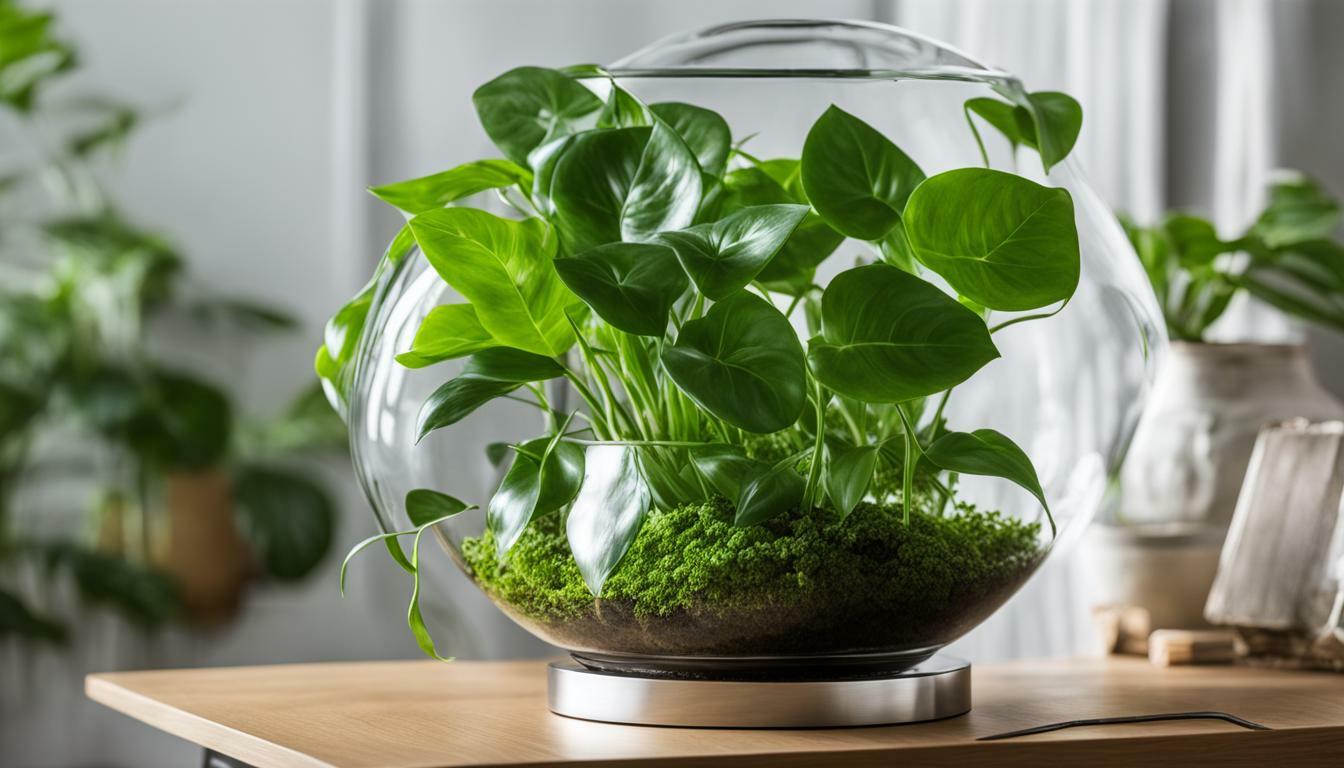Are you interested in growing lush Terrarium Plants Pothos? Look no further! This complete guide will provide you with expert care tips and everything you need to know about cultivating these beautiful houseplants in your terrarium. Pothos plants are popular for terrariums because they are adaptable and can thrive in various light conditions. Some suitable varieties for terrariums include Golden Pothos, Neon Pothos, Marble Queen Pothos, and Silver Pothos.
- Pothos plants are well-suited for terrariums due to their adaptability to different lighting conditions
- Popular Pothos varieties for terrariums include Golden Pothos, Neon Pothos, Marble Queen Pothos, and Silver Pothos
- The process of planting Pothos in a terrarium involves proper preparation and selection of a healthy plant
- Caring for terrarium Pothos requires providing adequate light, watering, pruning, and adding nutrients
- Avoid common mistakes such as overwatering and lack of light to ensure the health of your Pothos plants
Why Pothos is Perfect for Terrariums
Pothos plants are the perfect choice for terrarium gardening. Not only are they adaptable and easy to care for, but they also thrive in low light conditions and have the added benefit of purifying the air. These qualities make them ideal indoor plants, especially for those with limited access to natural sunlight.
One of the key reasons why Pothos plants are popular for terrariums is their ability to thrive in low light. They can tolerate a wide range of light conditions, including fluorescent lighting, making them suitable for offices, bathrooms, and other areas with limited natural light. This adaptability makes them low light plants that can bring greenery and life to any indoor space.
In addition to their adaptability, Pothos plants are also known for their air-purifying properties. They have been proven to remove harmful toxins, such as formaldehyde and benzene, from the air, making them excellent choices for improving indoor air quality. This makes them not only aesthetically pleasing but also beneficial to your health.
| Variety | Highlights |
|---|---|
| Golden Pothos | Golden green leaves with marbled patterns |
| Neon Pothos | Bright green leaves that glow under UV light |
| Marble Queen Pothos | Leaves with a mix of green and white marbled patterns |
| Silver Pothos | Leaves with silvery-white variegation |
To add variety and visual interest to your terrarium, there are different Pothos varieties to choose from. Golden Pothos, Neon Pothos, Marble Queen Pothos, and Silver Pothos are some popular options for terrariums. Each variety has its own unique leaf color and pattern, allowing you to create a stunning display within your terrarium.
When it comes to low-maintenance indoor gardening, Pothos plants are hard to beat. They require minimal care and attention, making them perfect for those who may not have a green thumb. As long as you provide them with the right amount of water, light, and occasional fertilization, your Pothos plants will thrive and bring beauty to your terrarium.

When it comes to selecting the perfect Pothos variety for your terrarium, you have several attractive options to consider, such as the Golden Pothos, Neon Pothos, Marble Queen Pothos, and Silver Pothos. These varieties not only add a touch of lush greenery to your terrarium but also thrive in the enclosed environment, making them ideal choices for terrarium gardening.
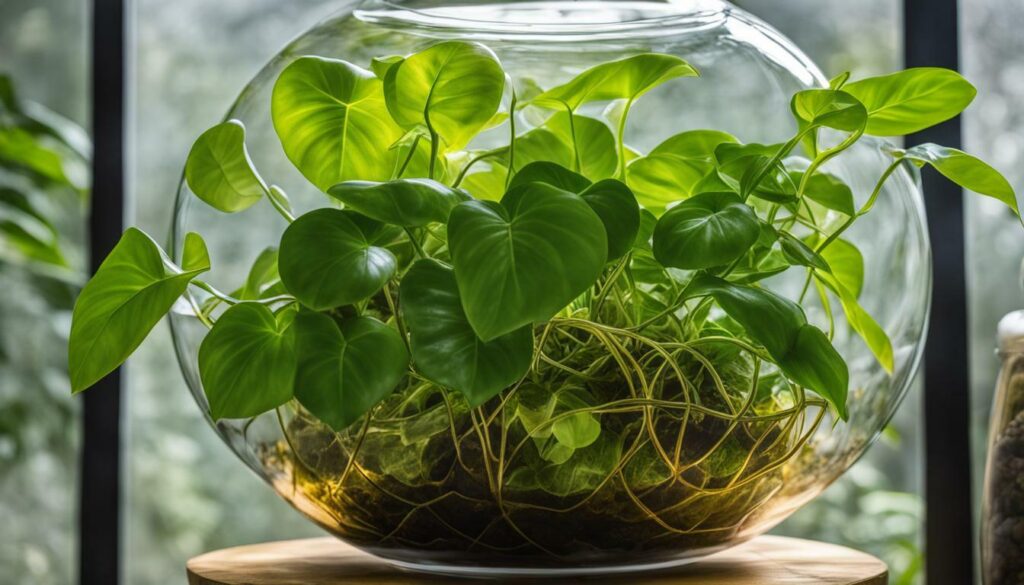
| Variety | Description | Light Requirements |
|---|---|---|
| Golden Pothos | A popular variety known for its beautiful, heart-shaped leaves with golden variegation. | Medium to low light. |
| Neon Pothos | This variety features bright neon green leaves that add a pop of color to any terrarium. | Bright, indirect light. |
| Marble Queen Pothos | With its stunning green and white marbled leaves, this variety brings elegance to your terrarium. | Medium to low light. |
| Silver Pothos | The Silver Pothos stands out with its silvery leaves and is perfect for creating a unique terrarium display. | Low to medium light. |
Each of these Pothos varieties offers its own unique charm, adding visual interest and beauty to your terrarium. Whether you prefer the warm tones of the Golden Pothos or the vibrant hues of the Neon Pothos, you can select the variety that best suits your style and terrarium setup.
Golden Pothos
The Golden Pothos, also known as Epipremnum aureum, is a classic choice for terrariums. Its heart-shaped leaves feature golden variegation, adding a touch of elegance to any terrarium setup. This variety thrives in medium to low light conditions, making it ideal for indoor environments. The Golden Pothos is not only visually appealing but also easy to care for, making it a popular choice among terrarium enthusiasts.
“The Golden Pothos stands out with its striking leaves, making it a favorite choice for those looking to create a captivating terrarium display.” – Terrarium Enthusiast
Neon Pothos, also known as Epipremnum aureum ‘Neon,’ is a vibrant and eye-catching variety that brings a burst of color to your terrarium. Its bright neon green leaves add a cheerful and lively touch to any indoor setting. The Neon Pothos thrives in bright, indirect light, making it an excellent choice for terrariums placed near windows or under grow lights. With its stunning foliage and low-maintenance nature, the Neon Pothos is a fantastic addition to any terrarium garden.
Steps to Planting Pothos in Your Terrarium
Ready to plant your Pothos in the terrarium? Follow these simple steps to ensure a successful and thriving terrarium garden:
- Prepare the terrarium: Start by choosing a suitable terrarium container that is clear and provides enough space for the Pothos to grow. Clean the container thoroughly to remove any dirt or residue.
- Select a healthy plant: Choose a Pothos plant that is healthy and free from any signs of disease or pest infestation. Look for vibrant green leaves and strong stems.
- Plant the Pothos: Create a suitable growing medium in the terrarium using a mix of well-draining potting soil and peat moss. Make a hole in the soil and gently place the Pothos plant, ensuring the root system is covered. Firmly press the soil around the base of the plant.
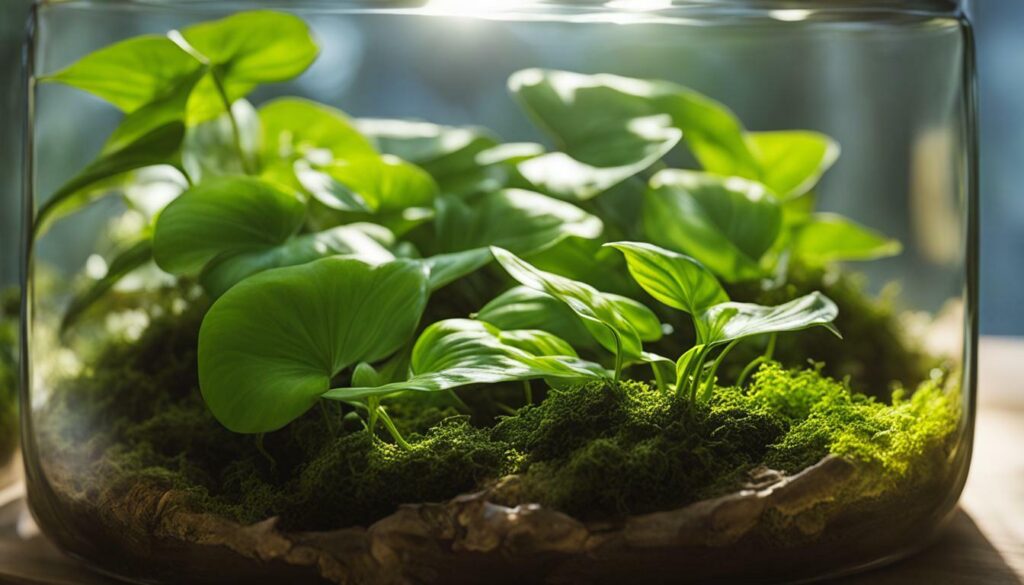
Care for the terrarium: After planting the Pothos, it’s essential to provide proper care to ensure its growth and health. Place the terrarium in a location with bright, indirect light. Avoid direct sunlight, as it can scorch the leaves. Maintain a consistent temperature between 65-80°F (18-27°C) to promote optimal growth. Water the Pothos when the top inch of soil feels dry, ensuring not to overwater as this can lead to root rot. Feed the Pothos with diluted houseplant fertilizer once a month to provide essential nutrients.
By following these simple steps and providing the right care, you can enjoy lush and thriving Pothos plants in your terrarium. The vibrant green foliage will not only beautify your space but also contribute to improved air quality!
Caring for Your Terrarium Pothos
Proper care is crucial to keep your terrarium Pothos happy and thriving. Here’s what you need to know to ensure their well-being.
Watering is one of the most important aspects of Pothos care in a terrarium. These plants prefer slightly moist soil, but overwatering can lead to root rot. To avoid this, allow the top inch of soil to dry out before watering again. Be sure to use well-draining soil and a container with drainage holes to prevent water from accumulating.
Lighting is another key factor in the success of your Pothos plants. While they tolerate low light conditions, they thrive in bright, indirect light. Placing them near a north or east-facing window is usually ideal. Avoid exposing them to direct sunlight, as it can scorch their leaves. If natural light is limited, you can supplement with artificial grow lights.
Regular pruning is necessary to ensure your terrarium Pothos maintains its lush appearance. Trimming back leggy stems and removing any yellow or dead leaves will promote new growth and maintain a compact shape. Additionally, pruning helps prevent the plant from becoming overcrowded within the terrarium, allowing for proper airflow and reducing the risk of pests or diseases.
| Essential Care Tips for Terrarium Pothos |
|---|
| Water infrequently, allowing the top inch of soil to dry out before watering again. |
| Place your terrarium Pothos in a spot with bright, indirect light. |
| Regularly trim back leggy stems and remove yellow or dead leaves. |
| Monitor the humidity levels within the terrarium and mist the leaves if necessary. |
| Feed with a diluted houseplant fertilizer once a month during the growing season. |
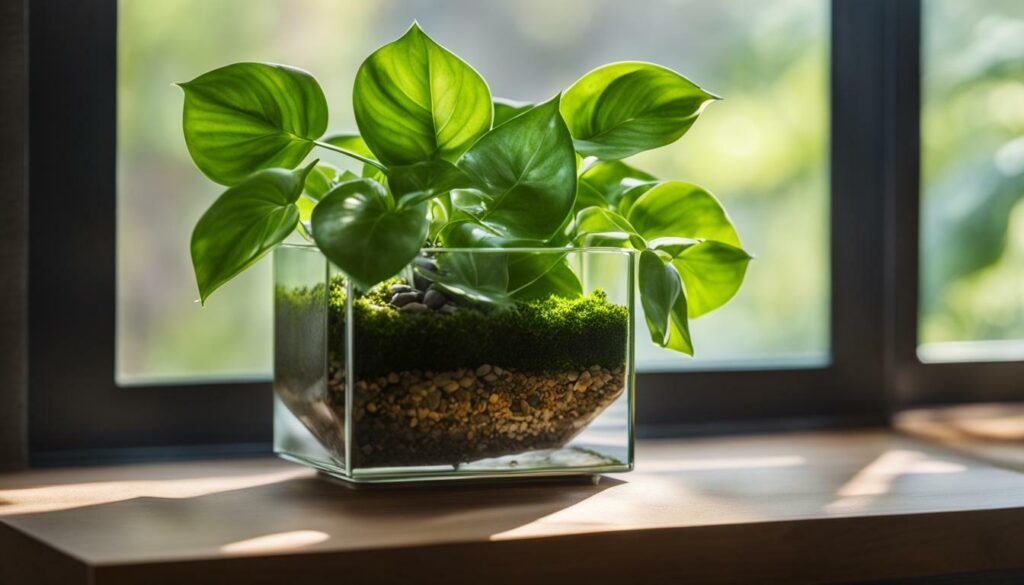
“Proper care is crucial to keep your terrarium Pothos happy and thriving.”
Maximizing Pothos Growth in Your Terrarium
Want to make sure your terrarium Pothos plants reach their full potential? Follow these tips to maximize their growth and enjoy a lush, thriving terrarium garden.
Pothos plants are known for their ability to purify the air and thrive in low light conditions, making them perfect for terrariums. To promote optimal growth, it’s important to provide them with the right care and conditions. Here are some key factors to consider:
- Light: Pothos plants are considered low light plants, but they still require some indirect sunlight to grow. Place your terrarium in a location that receives bright, indirect light. Avoid direct sunlight, as it can scorch the leaves.
- Watering: Proper watering is crucial for the health of your Pothos plants. Allow the top inch of soil in the terrarium to dry out before watering, and then thoroughly water the soil until it drains from the bottom. Avoid overwatering, as it can lead to root rot.
- Adding Nutrients: While Pothos plants don’t require frequent fertilization, providing them with diluted houseplant fertilizer once a month can promote healthy growth. Follow the instructions on the fertilizer packaging for the correct dilution and application method.
- Pruning: Regular pruning helps to maintain the shape and promote bushier growth in Pothos plants. Trim off any yellow or damaged leaves, and prune back long vines to encourage branching.
By following these tips, your terrarium Pothos plants will thrive and create a stunning display in your home. Remember to monitor their growth and make adjustments to the care routine as needed. With proper care, your Pothos plants will provide you with a beautiful and vibrant terrarium garden.
| Light: | Indirect sunlight, avoid direct sunlight |
|---|---|
| Watering: | Allow top inch of soil to dry out before watering |
| Adding Nutrients: | Diluted houseplant fertilizer once a month |
| Pruning: | Regularly trim yellow or damaged leaves, prune back long vines |
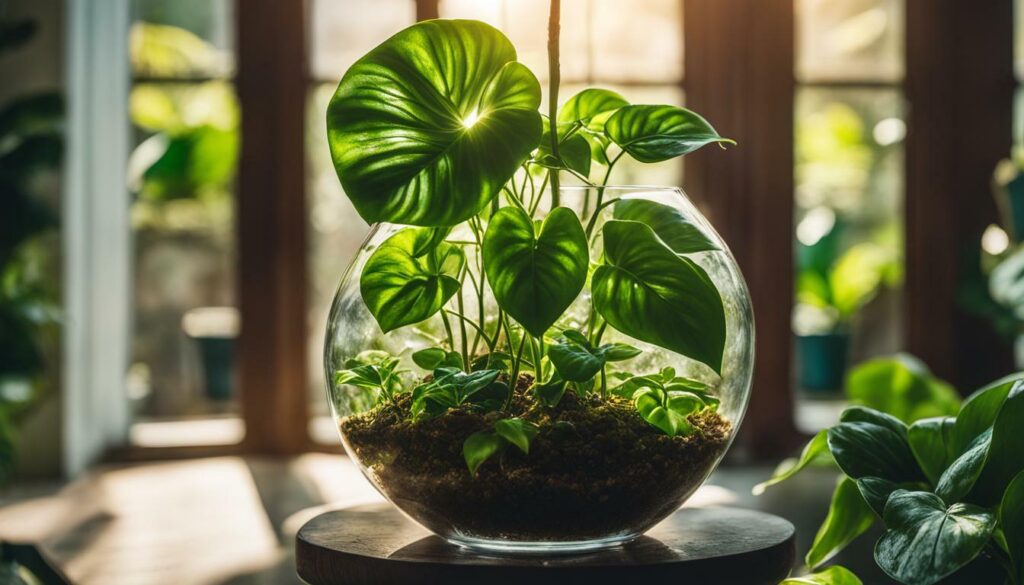
While Pothos plants are generally low-maintenance, there are a few common mistakes to watch out for when growing them in your terrarium. Avoid these pitfalls to keep your plants healthy and happy.
- Overwatering: One of the most common mistakes terrarium enthusiasts make is overwatering their Pothos plants. These tropical plants thrive in moderately moist soil, but they do not like to sit in water. It’s important to let the soil dry out slightly between watering to avoid root rot. Remember, it’s better to underwater than to overwater your Pothos.
- Lack of Light: Pothos plants are known for their ability to tolerate low light conditions, but that doesn’t mean they can survive in complete darkness. Be sure to place your terrarium in a location that receives bright, indirect light. Avoid direct sunlight, as it can scorch the leaves.
“Overwatering and lack of light are common mistakes that can lead to the decline of your terrarium Pothos. Take care to find the right balance for these plants and watch them thrive.”
In addition to these two common mistakes, it’s important to keep an eye out for other factors that can affect the health of your Pothos plants. For example, overcrowding the terrarium can lead to poor air circulation, which can create a humid environment that is conducive to pests and diseases. It’s also essential to regularly inspect your terrarium for any signs of pests, such as spider mites or mealybugs. Early detection and intervention can prevent the infestation from spreading.
By avoiding these common mistakes and providing your terrarium Pothos with the right care, you can enjoy lush, thriving plants that add beauty and greenery to your indoor space.
Table: Common Mistakes to Avoid
| Mistake | Consequence |
|---|---|
| Overwatering | Root rot, yellowing leaves |
| Lack of Light | Pale, leggy growth |
| Overcrowding | Poor air circulation, pest and disease susceptibility |
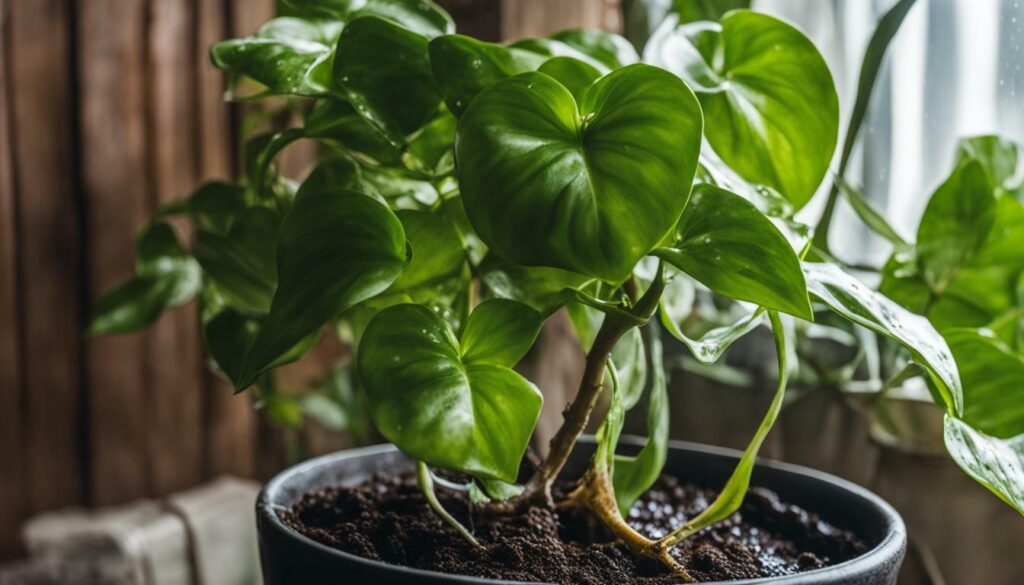
Dealing with Pests in Your Terrarium
Pests can sometimes find their way into your terrarium, but don’t panic! With the right approach, you can combat them effectively and keep your Pothos plants pest-free. One natural and safe method to control pests is by using insecticidal soap. It contains gentle ingredients that suffocate and kill pests like aphids, mealybugs, and spider mites. To use it, simply dilute the soap according to the instructions on the bottle and spray it onto the affected areas of your terrarium. Be sure to cover both the tops and bottoms of the leaves, as pests often hide underneath.
Another effective option for pest control is neem oil. It is derived from the neem tree and acts as both an insecticide and a fungicide. Neem oil works by disrupting the feeding and reproductive systems of pests, ultimately leading to their demise. Mix the neem oil with water and apply it to the infested areas of your terrarium using a spray bottle. Remember to follow the instructions on the packaging for proper dilution ratios and application methods.
| Pest Control Method | Advantages | Disadvantages |
|---|---|---|
| Insecticidal Soap | – Natural and safe for plants and humans – Effective against a wide range of pests – Easy to use |
– Needs repeated application for severe infestations – May cause leaf burn if used in high concentrations |
| Neem Oil | – Natural and organic – Controls both pests and fungal diseases – Long-lasting effects |
– Has a strong odor – Can be toxic to fish and other aquatic animals if it enters water sources |
It’s important to note that prevention is key when it comes to pest control. Regularly inspect your terrarium for signs of pests, such as discolored leaves, sticky residue, or webbing. If you spot any, take immediate action to prevent the infestation from spreading. Additionally, maintain good hygiene by keeping your terrarium clean and removing any dead or decaying plant material.
By implementing these pest control methods and staying vigilant, you can protect your terrarium Pothos plants from unwanted pests and ensure their continued health and beauty.

Your terrarium can be more than just a plant haven; it can also be a visually stunning display. Discover how to add decorations that will complement your terrarium plants and elevate their overall beauty.
When it comes to terrarium gardening, decorations play a crucial role in creating an aesthetic appeal. By carefully selecting and placing decorative elements, you can transform your terrarium into a miniature landscape that is both captivating and enchanting. Here are some ideas to inspire your creative side:
- Natural elements: Incorporate natural items such as small rocks, pebbles, or driftwood to create a realistic scene. These elements not only add texture but also mimic the natural environments where the plants would typically grow.
- Miniature figurines: Introduce charming figurines like tiny animals, fairy garden characters, or whimsical objects to infuse a sense of wonder and playfulness into your terrarium. These figurines can be placed strategically among the plants to add a touch of whimsy to the overall design.
- Moss and lichens: Enhance the visual appeal of your terrarium by incorporating different types of moss and lichens. These natural accents add depth, color, and texture to the terrarium, creating a lush and captivating environment.
- Colorful accents: Introduce pops of color with vibrant accents like small colored stones or decorative glass beads. These colorful elements can highlight specific areas of your terrarium and add visual interest.
Remember, the key is to strike a balance between the plants and the decorative elements. Avoid overcrowding the terrarium, as it may hinder the growth of your plants or create an overwhelming visual effect. Instead, opt for a few carefully selected pieces that enhance the beauty of your terrarium without overpowering it.
| Decorative Elements | Description |
|---|---|
| Natural elements | Incorporate rocks, pebbles, or driftwood to create a realistic scene. |
| Miniature figurines | Add tiny animals or whimsical objects for a touch of playfulness. |
| Moss and lichens | Introduce different types of moss and lichens for visual depth. |
| Colorful accents | Use colored stones or decorative glass beads to add pops of color. |
By incorporating decorations into your terrarium, you can create a captivating display that not only showcases your plants but also becomes an eye-catching centerpiece in any space. Let your creativity shine and enjoy the beauty of your terrarium garden.
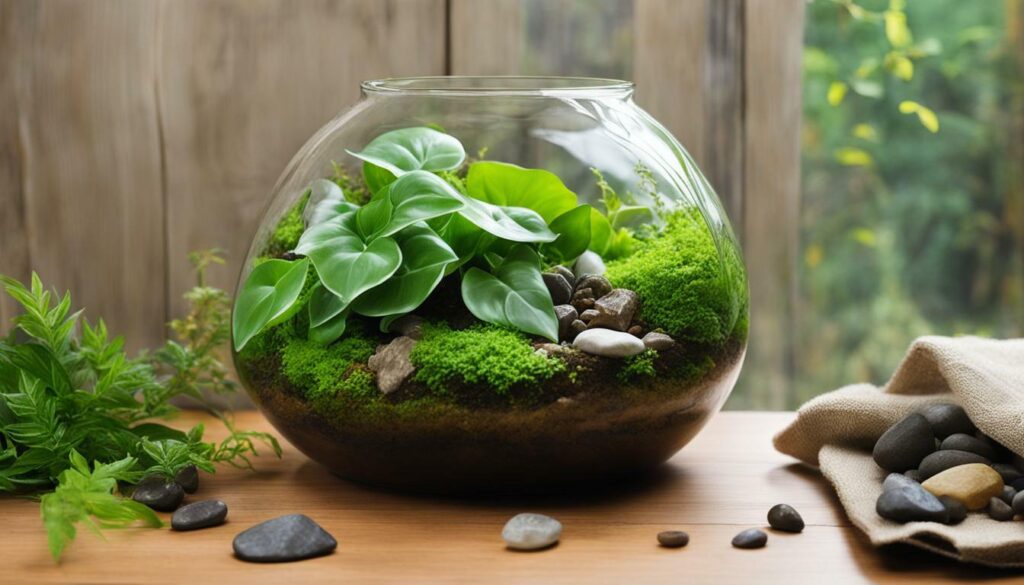
Want to take your terrarium Pothos to new heights? Learn how to train them to climb and vine with the help of trellises, poles, or wires for an impressive display. Trailing plants like Pothos are naturally inclined to climb and vine, creating a lush and visually appealing look in your terrarium.
To start training your Pothos to climb, provide them with a material to latch onto. One option is to use a trellis, which can be inserted into the terrarium soil and positioned vertically. Attach the trailing stems of your Pothos to the trellis, gently guiding them along as they grow. This will encourage vertical growth and create a beautiful cascading effect.
Another method is to use poles or wires placed strategically in the terrarium. Insert the poles or attach the wires securely into the terrarium walls and position them diagonally or horizontally. Allow the Pothos to wrap their tendrils around the poles or wires as they grow, providing support for their upward growth. This technique can create a stunning, jungle-like appearance in your terrarium.
Remember that training Pothos plants to climb and vine takes time and patience. Be gentle when attaching the stems to the support structures, and regularly monitor their growth to ensure they are on the right track. With the proper training and support, your terrarium Pothos will transform into a striking centerpiece, adding a touch of greenery and elegance to any space.
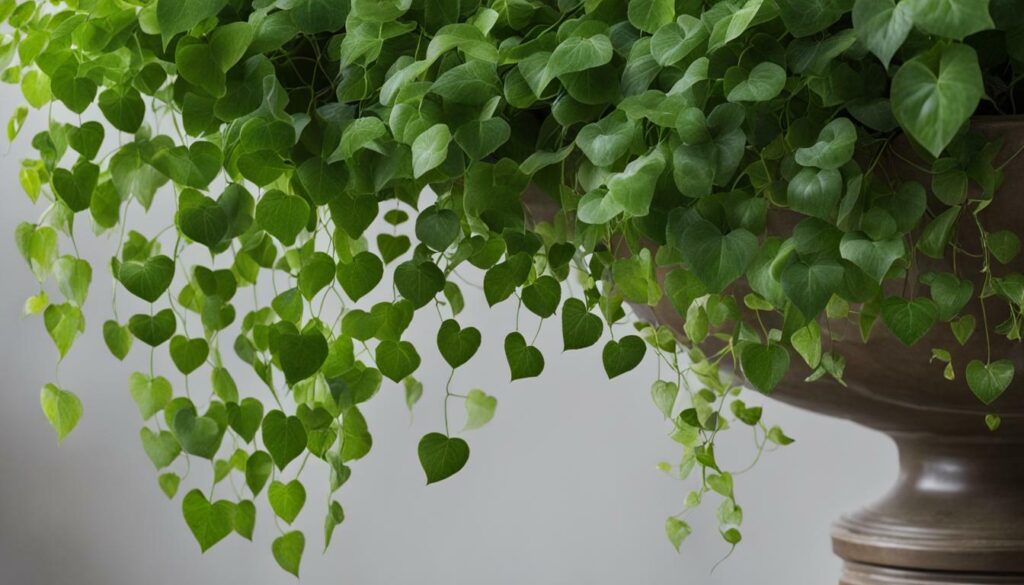
| Materials for Training Pothos | Benefits |
|---|---|
| Trellises | Vertical growth, cascading effect |
| Poles or Wires | Jungle-like appearance, support for upward growth |
Conclusion
Congratulations! You now have all the knowledge and tips you need to successfully grow lush Terrarium Plants Pothos. With proper care and attention to their specific needs, your Pothos plants will thrive in their terrarium habitat, bringing beauty and greenery to your indoor space.
Pothos plants are popular choices for terrariums due to their adaptability and ability to thrive in various light conditions. Whether you choose Golden Pothos, Neon Pothos, Marble Queen Pothos, or Silver Pothos, these varieties are well-suited for terrarium gardening.
Planting Pothos in your terrarium involves selecting the right terrarium and a healthy plant. Follow the steps of preparing the terrarium, planting the Pothos properly, and caring for the terrarium to ensure successful growth. Maximize your Pothos plants’ potential by providing them with adequate light, proper watering, and the necessary nutrients. Regular pruning will help maintain their shape and promote healthy growth.
It’s important to avoid common mistakes such as overwatering and providing insufficient light. Be mindful of pests and deal with them using the least harmful methods first. If necessary, resort to insecticidal soap or neem oil to protect your terrarium plants. Enhance the aesthetic appeal of your terrarium by adding decorative elements that suit your personal style.
To train your Pothos plants to climb and vine within the terrarium, provide them with a material to latch onto such as trellises, poles, or wires. This will allow them to grow and spread, creating a beautiful display of cascading foliage.
Remember to choose a suitable location for your terrarium, where your Pothos plants can receive bright, indirect light. Maintain appropriate temperature and water them as needed. Feeding with diluted houseplant fertilizer once a month can promote healthy growth and ensure the longevity of your lush Terrarium Plants Pothos.
How to care for different types of terrarium plants, such as Pothos and ZZ Plants?
Pothos and ZZ plants grow best in terrariums with well-draining soil and indirect sunlight. For Pothos, water when the top inch of soil is dry, and for ZZ plants, allow the soil to dry out between waterings. Both plants thrive in high humidity, making them ideal for terrariums.
FAQ
Why are Pothos plants popular for terrariums?
Pothos plants are popular for terrariums because they are adaptable and can thrive in various light conditions.
What are some suitable Pothos varieties for terrariums?
Some suitable Pothos varieties for terrariums include Golden Pothos, Neon Pothos, Marble Queen Pothos, and Silver Pothos.
What are the steps for planting Pothos in a terrarium?
The steps for planting Pothos in a terrarium include preparing the terrarium, selecting a healthy plant, and properly planting the Pothos.
How do I care for my terrarium Pothos?
Caring for your terrarium Pothos involves proper watering, providing adequate light, pruning, and other key aspects of Pothos care.
How can I maximize Pothos growth in my terrarium?
Maximizing Pothos growth in your terrarium involves providing adequate nutrients, optimizing lighting conditions, and utilizing their air-purifying capabilities.
What are some common mistakes to avoid when caring for Pothos in a terrarium?
Common mistakes to avoid include overwatering and lack of light.
How do I deal with pests in my terrarium?
When dealing with pests in your terrarium, start with the least harmful methods and use insecticidal soap or neem oil if necessary.
Can I add decorations to my terrarium?
Yes, decorations can be added to your terrarium for aesthetic appeal.
How do I train Pothos plants to climb and vine?
Training Pothos plants to climb and vine involves providing a material for them to latch onto, such as trellises, poles, or wires.
What is the proper care for terrarium Pothos?
Proper care for terrarium Pothos includes choosing the right location with bright, indirect light, maintaining appropriate temperature, and watering as needed.
How often should I feed my terrarium Pothos?
Feeding with diluted houseplant fertilizer once a month can promote healthy growth.

